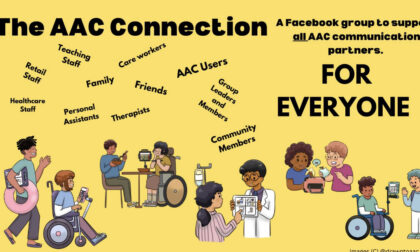Back at the start of the pandemic, I published here some information on communicating with AAC and video conferencing. Over time I have added and embellished this guidance based on my experiences and learning with different groups.
Appoint 2 hosts (minimum)
Running a video meeting can be quite complex, particularly when people are contributing in different ways. Contributions might include voice, using augmentative and alternative communication, signing, and/or using the chat feature.
- An important action is to agree on host roles early so nothing gets missed.
- One host should have the privileges to open and close the meeting, admit guests, and in an emergency close down the meeting swiftly.
- The second host is likely to be the lead person or moderator. This means conducting the meeting so it runs smoothly. Tasks might be leading on a presentation or facilitating the chat.
- Depending on the size of the video conference sometimes a third person is useful. Their role can be to monitor the chat and facilitate the contributions of those that type their input. In addition, if there are more people attending than can be shown on one screen they can watch for contributions.
Agree agenda, date, and timings
Pre-planning the session
In order for a meeting to run smoothly it might be helpful to consider during planning the following:
- Agree on who will arrange the session and send out the key information in the invitations and notifications before the meeting section.
- Decide who will lead on each question/discussion point.
- When one person leads the other to monitor the chat and ‘hands up’ so no contributions are lost.
- Agree on who will open the meeting/discussion and who will close the meeting.
- Decide who will take any actions to follow up. When people are using AAC it might help to choose someone who has a Personal Assistant present to make notes).
Invitations and notifications before the meeting:
- Arrange the meeting and send out joining instructions eg Zoom, Teams, Hangouts.
- Send out the meeting discussion topics well in advance.
- Add behaviour and expectations information to the joining instructions (see below).
- Ask participants, if possible, to please pre-programme contributions/thoughts.
- This allows time for everyone to participate.
- It also means everyone can listen to others rather than focus on their own programming.
- This means each person can check they have the vocabulary in advance.
- Assure participants there will still be an opportunity for a spontaneous chat. Some meetings open 30 minutes early to allow for this. Others close 30 minutes after the formal meeting ends.
Ground rules should be communicated at the beginning of the meeting
- Ground rules are for everyone as they save time and let everyone contribute.
- Decide if there should be introductions. Everyone has their name on the screen, unless it is a very small group introductions can take time.
- Encourage people to feel free to introduce themselves more fully on the chat.
- When people wish to speak please put up their hand, raise the hand on the toolbar, or put a single character in the chat.
- The hosts will try to use participants’ names to bring them into the conversation, or for them to make their contribution.
- If you have already spoken, and want to contribute feel free to put additional comments and questions in the chat. The hosts will try to bring you back into the discussion as appropriate.
- When the meeting is specifically for people using AAC there might be a rule only those using AAC can contribute. The exception is when someone is using a resource such as a communication board. In this case, an assistant may verbalise a completed message.
Behaviour and Expectations
A good time to send these is with the individual invitations and log-in directions. The aim is to ensure that all sessions provide a safe and enjoyable place for everyone. You may wish to change these for your particular meeting. However, try and make it clear you expect all attendees to follow the guidelines published:
- Attend on time.
- Show respect to hosts and fellow attendees.
- Value and respect the opinion of other attendees.
- Do not use abusive or offensive language.
- Do not engage in disruptive behaviour or act in an inappropriate manner to other attendees.
- Recordings/photos/screenshots of the session should only be taken with permission.
You can find more of my thoughts on AAC and video conferencing. This includes ensuring you can make a contribution during a video discussion here. This includes guidance for an AAC user and for the meeting host.
My thanks go to everyone in all the meetings I have participated in during the last 2 years. These experiences have allowed me to compile this list of suggested guidance.





If you found this interesting or
helpful please feel free to share.